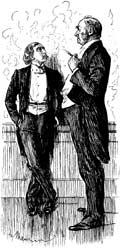Anybody out there waffling about whether or not to sign up for David Isenberg’s WTF 2024? I’ve been looking through the list of participants and I’m intimidated. I’m glad that I’ve signed up… my recent assignments have been ridiculously computernoid and I need to get back into the telecom scene.
A meme I haven’t been able to get my mind around is the thing about dumbing down the network and putting the intelligence on the periphery. The model is seductive, but it requires infinite bandwidth and new ways to manage accounting. I think. There’s a lot to be learned from the experts at WTF.
There are many professional meetings this spring, from PyCon to PingCon with the big gouda in Cambridge. David Isenberg’s WTF2004 from April 2 to 4 at a retreat center outside of Chapaqua , New York. Berkman Fellow Wendy Seltzer is going to be there putting the IP in IP.




{ 1 comment… read it below or add one }
The Dynamic Driveler 02.28.04 at 9:17
(ha! I knew I was right on the conference you were referring to when you mentioned it over at Jeneane’s awhile back I too wish I were going - time and money do not allow that als ).
I too wish I were going - time and money do not allow that als ).
The basic premise of David’d original essay, as I understood it, is that by moving control of information to the network edge you place control of services and information in the hands of the end user instead of being controlled in the heart of the telco’s network, and thus by the telco (or cableco).
The first step in that is an all tcp/ip network. tcp/ip allows end users to create their own services that bypass a traditional telco model of control. The second step is off the copper infrastructure and onto fiber (which has the potential for essentially unlimited bandwidth). This further reduces control of services by the telco as everything gets reduces to digital packets and the need to massage that data in the core (ATM - FRAME etc) is reduced to merely routing. The third step is fiber to the home which opens unlimited possibilities for new network services offered from the edge.
As you can see this does not bode well for traditional telco model. The fourth step is the traditional telco killer and that is the rise of community owned open access fiber networks. The open access model is where the real stupid network arises.
Separating services from network is something the telcos, not surprisingly, can not wrap their heads around. They have too much invested in their copper infrastructure that allows them to completely control, and thus profit from, the services they will alow to operate over those networks. By introducing a different model where the network infrastructure itself is operated on a non-profit or low margin for profit basis and granting access to that network, on an equal basis, to any service provider that wants access then you have killed the trad telcos and created a “stupid” network on which innovation and business can thrive.
Infinite bandwidth is not needed for this, just the potential for it (fiber). You’re right though that it does require a whole new idea on how to manage accounting. These types of networks are arising all over North America. Many of them are coming from Public Utility Districts who are, by law, prevented from offering telcom services themselves but can build network backbones and open them up to all who want access.
Here in Canada we have community network groups like CMON (http://www.cmon.ca) that are in the process of acquiring federal, provinicial and municipal funding to build huge non-profit open access fiber/wireless networks to bring services to rural areas that the Telcos and Cablecos won’t touch (although the work I did, along with another person 4 years ago was responsible for forcing the local ILEC to bring ADSL to 12 rural communities - their attempt to forestall the CMON network - didn’t work they missed the other 144 communities in the region),
I really don’t think, no matter how many mergers and acquisitions go on that the traditional telcos will survive. Their control model is inherently flawed in the digital age and that is David’s real point.